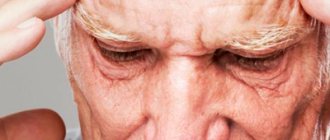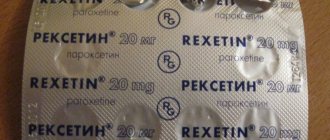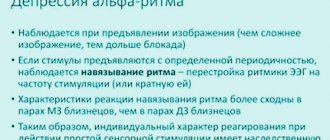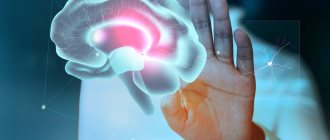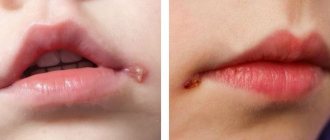Acute intoxication, stimulant intoxication
Acute intoxication due to the use of stimulants occurs stereotypically for each type of stimulant drug. Intoxication, as a rule, has four phases of development. The table below shows the characteristics of these phases using the example of injection ephedrone.
It should be noted that the clinical picture of drug intoxication when using stimulants is not uniform; it can change and be supplemented by related symptoms, depending on the substance being abused.
So, from the moment of using cocaine, a person’s thinking proceeds without delay or inhibition, and therefore is often characterized by “lightness of thoughts,” the direction of which completely depends on the environment. If the use occurs in private, a person’s reasoning changes with kaleidoscopic frequency in the form of memories of episodes from the past or fantasies about the future.
In intoxicated cocaine addicts, as a rule, auditory sensations are especially aggravated, which gives them a special brightness and reality. In this state, they feel in excellent physical shape, capable of any challenge and achieving high athletic results. Some of these sensations are indeed justified by their condition, but most of them are the result of a subjective change in perception and consciousness due to drug use.
Up
Phasicity during intoxication with CNS stimulants (table)
| Phase | Main manifestations and symptoms |
| Phase I | Development occurs rapidly and is presented in the form of disorders of consciousness. Main symptoms: feeling of insight, impaired ability of external perception; Against the background of euphoric sensations, a violation of the muscular-articular sense - proprio sensitivity - occurs, which is expressed in the form of a feeling of lightness, flight with short-term deafness. |
| II phase | Occurs, as a rule, with oral administration. The main symptoms are presented in the form of a narrowing of consciousness with various physiological sensations: maintaining a feeling of lightness, flight (attempts to jump to take off may be observed), the appearance of various pleasant sensations, both in the middle of the body and outside; wave-like sensations of pleasant warmth may occur, moving throughout the body; physiological bliss in the abdomen (epigastric region), a deceptive sensation of hair growth and a subjectively pleasant shiver. Attention is focused on emotional experiences with complete indifference to others. Drug addicts themselves describe the level of euphoric sensations as a “whole body orgasm.” |
| III phase | It begins with a sharpening of attention to the environment, but the narrowing of perception continues. Everything that happens around is perceived as in sympathicotonia: objects seem bright, saturated, attention is sharpened to little things, which are perceived as clearer and more contrasting. All this happens against a background of heightened mood, complacency with obsessive attacks of partiality and love for all living things. In a state of intoxication, a significant surge of strength and increased vitality are felt. An uncontrollable desire for creative work may arise: intoxicated people may begin to draw, play musical instruments, demonstrate extraordinary knowledge in various fields of science, build theories and propose solutions to complex philosophical dilemmas. There is an uncontrollable desire to communicate, people can run, fuss and “talk” quickly. Their verbosity has a pronounced superficial character with unclear associations, fragmentation and persistence, bordering on arrogance (perseveration) and confusion of associations, in one subject. Sexual desire and potency increase sharply with an increased level of sexuality. |
| IV phase | The last, “initial” phase of intoxication begins with the restoration of the volume of consciousness, clarity of perception gradually returns to normal. The level of pleasant, complacent sensations decreases. Euphoria subsides, changing to a feeling of depression, increased irritability, and a desire to be alone. Against the background of a lowered threshold of perception, the impressions no longer bring pleasure, they seem excessive and not worth attention. Against the background of hypersensitivity of almost all sense organs, a painful reaction to sounds (hyperacusis) and light (especially photophobia in the daytime) is observed. Attacks of senestopathy may occur, manifesting as vague uncomfortable sensations in different parts of the body: “pins and needles”, fever, tremors and uncontrollable muscle reflexes. Shallow sleep may occur. There is emptiness, lethargy, drowsiness without falling asleep. |
Up
The state of euphoria from the use of stimulants
Euphoria when using stimulants occurs due to the specific effect of the corresponding drug on the mucous membrane due to inhalation, injection or oral administration. If we take the strength of drug intoxication from ephedrine as a unit, then the intensity of action of the most common stimulants will be:
- ephedrine - 1;
- gracidin - 1.7;
- amphetamines (benzedrine, phenamine) - 5;
- pervitin - 10;
- cocaine - 2-10 (depending on quality).
The doses required to obtain high euphoric sensations are individual for each person. The duration of drug intoxication depends entirely on the type and method of drug use. Often, drug addicts experience an increased sense of time (an hour may seem like a blink to them). For example, intoxication from amphetamines lasts up to 3 hours, cocaine - 1.5 and ephedrone - 4.5 hours. After leaving the state of intoxication, symptoms of somatic and mental weakness can be observed for several more days, and the normalization of sleep continues for several more days, as does appetite, sexual desire (libido) and potency.
Up
Definition and chemistry
Photo by Tim Samuel: Pexels
Euphoria is a positive emotion or affect that is felt as a sudden feeling of happiness, delight, against the backdrop of a slowdown in mental activity. The chemistry of euphoria is quite simple. The human body produces special substances: hormones.
There are a large number of them, but in the case of a state of euphoria, we will be interested in dopamine and endorphins. It is to them that we owe the euphoric effect. Their function in our body is to relieve the nervous system during periods of stress and serve as a kind of reward system.
Dopamine plays the role of a stimulating neurotransmitter, which helps to increase motor activity, reduces motor retardation and stiffness, and serves to reduce muscle hypertonicity. The level of dopamine in the blood plasma increases with injuries, burns, anxiety, and fear. This allows you to speed up the process of adaptation of the body to stressful situations.
The second character: endorphins. Endorphins are chemical compounds that are produced in neurons of the brain and, in their mode of action, are similar to the action of opiates. They are able to reduce pain and influence the emotional state.
Techniques for achieving euphoria
Abuse without addiction
Dependence on stimulants develops very rapidly, and in terms of speed of development it is second only to opium addiction. The development of physical and mental dependence becomes most intense when taking pervitin by injection, which almost immediately causes the appearance of a compulsive desire to use it.
The development of dependence on amphetamines is somewhat similar to the development of alcoholism, characterized by long-term episodicity, which is reminiscent of the “binge” episodes of alcoholics.
Addiction develops in two types: “weekend use”, which lasts 1-2 days a week with complete abstinence from drugs during the remaining working days, or “Swedish cycle”, in which use occurs over several days, several times a day, as a rule, at intervals of 2-4 hours. During this “marathon”, drug addicts do not sleep all the time and refuse to eat.
Up
Why is euphoria dangerous?
Euphoria can greatly harm a person. An enthusiastic state observed over a long period of time impairs the functioning of self-control mechanisms. This leads to unbalanced behavior, uncontrollability, and hysteria. This behavior can be harmful to both the patient and people around him.
Other effects of euphoria include:
- dissociation of mental activity;
- social maladjustment;
- loss of sense of reality;
- toxic dementia.
The narcotic type of euphoria is often accompanied by euphoric pain: severe physical or psychological discomfort, which the patient talks about with pleasure and joy. This is a dangerous condition that can cause serious injury.
Important! In some cases, euphoria can be fatal.
Drug addiction with stimulant abuse
Ephedrone, pervitin and amphetamine addiction
The development of drug addiction syndrome when using stimulants occurs quite quickly - within two to three weeks of systematic use or three to five injections. Manifestations of mental dependence on stimulants precede manifestations of altered reactivity syndrome. An uncontrollable desire to find a new dose of the drug and repeat the pleasant sensations appears even after using relatively small doses of the drug. Addiction to these stimulants has three stages of development.
Up
I (first) stage
The first stage of the development of drug addiction from these stimulants is presented in the form of a mental dependence syndrome, which is characterized by a strong attraction to drug use, absorbs almost all the thoughts and consciousness of the drug addict, pushing into the background all habitual activities and important matters. All sensations that previously brought pleasure are subjectively devalued against the background of the euphoric experiences of the drug addict. An altered reactivity to the drug quickly develops, and an increase in tolerance occurs due to an increase in the number of cases of deliberate abuse.
Along with the change in the main effects of action, the duration of exposure to a single dose of stimulants is also reduced. The strength of the somatic effects that manifest themselves in the 4th phase of intoxication also decreases: a feeling of cardiac disorders, headache, musculocutaneous tension, unpleasant obsessive sensations of pain, and urinary disorders. Manifestations of general weakness also disappear, and vigor appears. The ability to fall asleep and appetite are subsequently absent. In the third phase of drug intoxication, orderly behavior without excessive mobility is already observed, but further there is a need for communication, creative work and intellectual activity.
Anesthesia with stimulants acquires a new rhythm - use continues immediately after the main effects of the previous dose have ceased. The increase in tolerance increases five to six times, but the single dose remains unchanged. Continuous anesthesia, as a rule, lasts up to four days, often around the clock. All this ultimately ends in general exhaustion, which is clinically similar to the consequences of stopping the action of a single dose, but with a more expressive effect. The onset of sleep is possible after 6-10 hours of cessation of anesthesia with a duration of up to 2 days, during which energy potential is restored, after which patients experience uncontrollable hunger, eat a lot, with a preference for sweet and fatty foods.
After recovery, patients again have a craving for drugs, and abuse repeats its circular cycle. The inability to take another dose of the drug leads to mental discomfort and dissatisfaction, impaired ability to concentrate, the inability to work productively, all the thoughts of the drug addict are concentrated on finding a new dose of the substance. The cyclical rhythm of abuse, characteristic of this type of drug addiction, acquires signs of full formation.
Up
II (second) stage
At the second stage of drug addiction, average daily tolerance reaches its highest level with a decrease in the duration of action of a single dose. Daily doses of pervitin and ephedrine are 0.8 and 4-6 g, respectively. The period of anesthesia becomes more frequent, use occurs every 1.5-4 hours, lasts from 5 to 10 days with 2-3 days of sleep. There is a change in the nature of drug intoxication, the euphoric feeling is reduced to 2 hours. Pleasant sensations lose their brightness, leaving only a feeling of warmth in the epigastric region (epigastric region). Comprehensive motor hyperactivity changes to monotonous activity of the same type (for example, writing poetry or drawing).
The fourth phase of intoxication is characterized by the presence of emotional tension, interspersed with irritation and attacks of groundless anxiety. In some cases, signs of dysphoric syndrome with attacks of aggression are observed. With chronic and long-term abuse of stimulants, the euphoric effects are unstable, which can easily disappear under the influence of external factors (for example, oral use or touching the body). The period of anesthesia acquires the signs of a well-coordinated and comfortable individual system of use for the addict.
Mental dependence syndrome manifests itself in the second stage and then only during remission. The general clinical picture of drug addiction syndrome with stimulant abuse manifests itself only in the form of symptoms of physical dependence. In parallel with the development of compulsive cravings, signs of drug withdrawal begin to appear, in which drug addicts are in an extremely tense state, showing anger and a tendency to aggression. The behavior of patients becomes impulsive with signs of a narrowed consciousness; all the attention of the addict is concentrated exclusively on finding a new portion of the narcotic substance. Among the somatic signs, characteristic manifestations are:
- mydriasis (dilated pupils);
- dry mucous membranes;
- tremor;
- increased reflex excitability;
- vascular and muscular hypertension;
- tachycardia;
- loss of sleep and interest in food.
Up
Withdrawal syndrome
Among the signs of withdrawal syndrome in ephedronovium, pervitinovium and amphetamine drug addiction, characteristic somatovegetative changes in the body first appear, such as:
- headache attacks
- heart rhythm disturbances (arrhythmias and angina)
- manifestations of suffocation in a calm state;
- feeling of powerlessness and “brokenness”;
- fibrillary twitching and spasms of facial and linguistic muscles.
Other signs of withdrawal include: loss of coordination, ataxicity and intermittency of movements with excessive amplitude. Patients often yawn, they often feel feverish and sweat (hyperhidrosis). Dermographism of the skin is white (artificial urticaria, which is expressed in an abnormal reaction of the skin, resulting from minor mechanical impact). There is increased sensitivity to external stimuli, especially tactile ones (touch and pressure). During a medical examination, when touched, patients shudder and sharply jerk away from those conducting the examination.
Among the signs of mental disorders, anxiety, unhealthy suspicion of others and paranoia clearly stand out. There is no phasicity of abstinence. Even after receiving medical care, patients remain in an agitated state for some time (mostly for 2-3 days). Patients remain in a post-withdrawal state for 1-1.5 months with signs of fatigue, adynamism and melancholy, sometimes become hysterical, cry and show apathy in everything, complain about the hopelessness of their situation, and confidently lose weight. Characterized by the manifestation of lability (functional mobility of nervous and muscle tissue, characterized by the highest frequency with which the tissue can be excited in response to irritation), chaotic behavior and asymmetry of vegetative indicators. During the peak period of withdrawal, psychosis may occur, usually delirium.
Up
III (third) stage
At the III (third) stage of drug addiction, when stimulants are abused, anesthesia takes on a cyclic form, but with a reduced duration and dosage. At the peak of intoxication, somatic sensations are not as expressive as in the early stages. Mental and motor arousal is insignificant, the increase in mood is short-lived and unstable. Drug use mainly occurs to avoid withdrawal symptoms. The speech of drug addicts is inhibited, unproductive and with reversals (constant repetition of the same phrase). Sometimes manifestations of sexual aggression are observed in the form of paedo- and gerondophilia. Self-cessation of abuse is possible only in the case of mental or physical inability to further drug addiction.
Withdrawal symptoms occur 12-20 hours after stopping drug use. In this case, there is an extremely unstable emotional state and mood of the patient, which changes repeatedly during the day from hypomanic to irritable and paranoid. Periodically there are causeless attacks of anxiety of internal tension. On days 2-4 after refusal, compulsive desire intensifies, accompanied by irritability, anger and rudeness. The duration of the dysphoric stage of withdrawal syndrome is from 12 to 24 hours, followed by remaining in an apathetic, lethargic and depressed state with significant physical weakness.
At stage III of drug addiction, continuous exhaustion and devastation of the drug addict’s mental sphere develops and leads to their complete inactivity. Cases of attacks of aggression and suicidal reactions are becoming more frequent. Patients quickly degrade morally and ethically.
Neurotrophic changes appear in the body in the form of premature aging of the skin, brittle nails and hair. Coordination of movements is impaired. The cranial nerve endings are affected, which manifest themselves in the form of: diplopia (visual impairment in which a visual object is perceived as double), ophthalmoplegia (paralysis of all or several muscles of the eye), paralysis of the hypoglossal nerve.
Up
Cocaine addiction
The clinical picture and stages of development of cocaine addiction in general are very similar to the abuse of ephedronic stimulants. In general, there are two characteristic types of this form of addiction - malignant periodic and chronic daily abuse.
Up
Malignant recurrent cocaine abuse
Malignant periodic abuse of cocaine is similar to binges in alcoholism with a duration of up to 10 days, during which drug addicts consume very high doses of the drug in amounts of up to 10 g per day. Termination of anesthesia occurs due to severe physical and mental exhaustion, requiring restoration of energy potential, usually within 5-6 days. Once reinstated, the abuse continues.
Up
Chronic cocaine abuse
With the exception of mental dependence, the first signs of cocaine addiction are: a rapid increase in tolerance, a change in the pattern of intoxication, and mental and somatic disorders of a progressive nature. The increase in tolerance is due to an increase in the dosage of the drug, at the onset of abuse - to enhance euphoric sensations, then - to avoid the consequences of withdrawal syndrome.
With the development of drug addiction, the euphoric effect of cocaine is completely neutralized. Persistent apathetic depression with anhedonia (inability to enjoy any activity) becomes common. Creative activity, which previously occurred against the background of drug intoxication, changes to complete apathy and inaction. Sexual dysfunctions occur in the form of impotence or amenorrhea (menstrual irregularities). The ability to concentrate is lost, mental activity and memory weaken. General exhaustion of the body occurs.
Somatic changes that occur in cocaine addicts are presented in the form of: perforation of the nasal septum, trigeminal neuritis, accompanied by pain. Cases of cocaine-induced epilepsy may often occur, which may gradually disappear with cessation of use.
Up
Withdrawal syndrome in cocaine addiction, cocaine addiction
Withdrawal syndrome in cocaine addiction (cocaine addiction) , as a rule, is represented by states of severe dysphoria with signs of chronic irritability and affective outbursts. In this state, patients are in a constant, causeless state of anxiety and depressed mood. Insomnia and drowsiness constantly alternate or are combined with each other in the form of insomnia with a feeling of drowsiness.
Against the background of withdrawal sensations, feelings of persecution mania, expressions of delusional and especially suicidal ideas are characteristic; this period is considered especially dangerous in terms of the likelihood of committing suicide. The “peak” period of withdrawal development occurs 2-4 days after cessation of use, but depressive states and irritability do not leave the patient alone for up to several months.
Up
Stimulant overdose
Cocaine overdose
As a result of an overdose of cocaine, against a background of feelings of anxiety and fear, a mania of persecution arises, expressed in the feeling and accusation on the part of the patient of those around him of a conspiracy or desire to deliberately cause him harm. This is also characterized by tactile hallucinations, manifested in pseudo-sensations of “insects crawling” on the skin (Magnana symptom) and so-called auditory acoasms - elementary auditory hallucinations in the form of individual sounds (noise, bells, exclamations, etc.). Thinking changes towards an unusual interest in everything around him, the patient looks closely at everything or listens. Movements of body parts, facial expressions and behavior become stereotypical, for example, patients may suddenly begin to put together objects that are different in content and incompatible.
Somatic and neurological disorders become extremely complex and manifest themselves, for example, in the form of cardiac arrhythmia or seizures. There is a serious risk of sudden cardiac arrest or respiratory depression, resulting in death.
Up
Overdose of pervitin, ephedrone
As a result of an overdose of pervitin or ephedron, perception disorders occur, manifested in the form of depersonalization (a person’s inadequate perception of his personality, his “I”) and derealization (inadequate perception of the world around him as unreal or remote). Following these symptoms, hallucinations (tactile, visual or auditory) also begin to appear. Somatic disorders include dry mucous membranes, pale complexion, a significant increase in blood pressure and arrhythmias in the form of extrasystole.
Up
Amphetamine overdose
As a rule, the clinical picture of an overdose of amphetamines is presented in the form of delusions of attitude (the patient thinks that everything around concerns only him) and persecution mania, which determines his behavior in this state. Auditory hallucinations are mostly absent; if they appear, it is only in the form of individual elements (bells, beeps or knocks, or one’s own name). The most characteristic somatic manifestations are severe cardiac arrhythmias.
Up
Get everything
The difference in the effect of these hormones is that dopamine creates a feeling of joy when you find something you need, while endorphin creates pain-relieving sensations such as ease and oblivion.
This is how everything was competently created and planned: I achieved my goal - get the dopamine candy; you hurt your knee - endorphins are already blowing into your wound. But here the question arises: “How can you get candy without effort, or experience feelings of euphoria without injury?”
The state of euphoria can be achieved in different ways. Conventionally, they can be divided into two groups:
- natural;
- artificial.
Atypical reactions to stimulant abuse
Amphetamine, pervitin and ephedrone paranoid
The first mention of the paranoid reaction resulting from the use of stimulants belongs to P. Connell (1958), who noticed that some time after using a significant dose of stimulants or injection, feelings of anxiety and fear suddenly and intensely increase. The drug addict begins to look around suspiciously, carefully examine those around him, listen to distant sounds or exclamations, and there are feelings that he is well aware of the evil intentions of strangers towards him.
The heterogeneity of psychotic manifestations is clearly illustrated by the following clinical example, which describes the characteristic manifestations of acute hallucinatory-paranoid syndrome with elements of delusional love-erotic ideas that arise as a result of the injection of pervitin:
“Drug addict, 28 years old. The total experience of regular anesthesia is 4 years; over the last year he has been injecting pervitin. As a result of the administration of the next dose of the drug (2 ml), psychomotor agitation immediately increased: the patient locked himself in the room and screamed, threw off his own clothes, declared that he was being watched by women with whom he had previously had relationships, and cut his clothes and socks into pieces. After hospitalization in a psychiatric hospital, he continued to be in an affectively tense state, demonstrated obsessive behavior towards the hospital medical staff, and clung to various questions of a formal nature. From time to time I listened to something and talked to myself. He was constantly immersed in himself and thought illogically. He stated that “everything around is a rig.” He tried to draw various geometric shapes on the walls under the pretext that this was a message to his beloved girl, whom he considered “his queen.” I gave these figures a special meaning, assigned them names with the words: “look, the square means: “Lena, I love you, you are the most charming in the world,” and the triangle means: “Karina, I wish you limitless happiness,” and so on Further. When asked by doctors why he didn’t describe these messages on a separate sheet of paper and send them to the addressee, he argued that: “only in this way will his beloved be able to read these messages and the whole country will see them.” I constantly felt a threatening tone in my direction in the words of those around me. He perceived the conversation with the doctor as a sign of his popularity with the words: “everyone loves me, I’m known as Elton John.” After several sessions of active therapy with antipsychotics, the mental state and behavior returned to normal. The activity changed to asthenia and general lethargy; the patient spent all his time in bed. A self-critical attitude towards the delusional ideas he had previously uttered appeared. Subsequently, the patient was discharged under the supervision of a narcologist with a recommendation for further drug treatment.”
Sometimes the first moments of such a pseudo “epiphany” can give the patient a certain pleasure, arouse interest, improve mood and experience from participating in important events. However, after a while, anxiety and an acute sense of danger, attacks of aggression and anger are sure to arise. Patients express delusional ideas about their involvement in everything that happens around them; in the words of people they everywhere see a threat, hints and conditioned signals for an attack. A characteristic feature of this type of paranoid is the rapid transition from delusional conclusions to actions caused by their occurrence. At the peak stage of paranoid development, auditory, predominantly verbal, hallucinations often occur: a feeling of “goosebumps crawling” throughout the body, which the patient is trying to catch, throw off, and the like. Psychotic paranoia continues for several days. In such patients, differential diagnosis is recommended for the acute onset of the paranoid form of schizophrenia.
Reference: according to an analysis of follow-up studies, 42% of Ephedronovian paranoids subsequently gradually turn into schizophrenia.
Up
Amphetamine confusion
Sometimes the state of amphetamine confusion can be found in the specialized literature under the name “amphetamine delirium.” This condition occurs predominantly during the first hour of taking the drug, or immediately after injection. It manifests itself in the form of confusion, suspicion and an obsessive feeling of fear. Patients make contact with great difficulty, are disoriented in space and time, and do not recognize those around them or their place of stay. They construct incoherent and fragmentary sentences with expressive emotional overtones. They demonstrate a tendency to objectively unjustified aggression, sometimes with manifestations of auditory and visual hallucinations. Among the somatovegetative signs, sympathicotonia in the form of mydriasis, tachycardia (rapid heartbeat) and pallor stands out. Amphetamine confusion continues for several hours or several days, followed by a transition to asthenic states with depressive overtones.
Up
Return to main section
